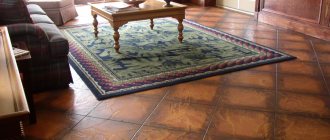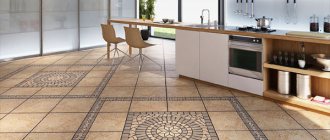The hallway is a high-traffic area, and therefore requires a stable and high-quality floor covering. And tiles are one of the most suitable options. Today we will tell you what is good about floor tiles in the hallway, we will share the best ideas and tips - both on selection and installation.
Floor tiles in the hallway
Choosing floor tiles for the hallway
First of all, understand that the load in the hallway is always increased - this includes dirt, abrasive substances (sand, other small particles), and reagents used in winter for sprinkling roads. Therefore, when choosing the best option, consider the factors below.
- Wear resistance, resistance . We are talking about abrasive substances, chemicals, as well as heavy objects (scratches and cracks should not appear on the floor if something is dropped on it).
- Appearance . Another important factor. The floor should be combined with the walls in the hallway, as well as with the finishing materials of neighboring rooms. To make the interior harmonious, pay attention to details.
- Invoice . The floor should not be slippery, because people can walk in the hallway with wet shoes. Therefore, it is better to refuse to buy glossy tiles.
Tiles that look like laminate are a popular choice. Since it helps to create a harmonious interior and visually combine the hallway with other rooms
Tiles imitating parquet
On a note! Let's take a look at the types of floor tiles and find out which option is best.
Prices for Tarkett floor tiles
Tarquette floor tiles
Types of floor tiles
When choosing a material, you need to evaluate its performance characteristics. Cost is also of great importance.
Ceramic tile
This coating is most often used for floor finishing. High-quality plates are obtained by pressing a special composition, the basis of which is clay. Products are produced glazed (with a glass surface layer) and unglazed.
Advantages of ceramics:
- It is easy to care for the coating; no special detergents are required;
- the material is resistant to moisture, so you don’t have to worry about the floor when the weather is inclement outside;
- the tiles are durable and highly durable;
- A wide selection of colors and textures allows you to realize any design fantasies.
Popular tile floor in the hallway.
Unfortunately, tiled flooring is not without its drawbacks. The material is not resistant to impacts from heavy objects. When solid, massive objects fall, the canvases may crack, especially if they are installed incorrectly or have poor preliminary preparation of the base.
Porcelain tiles
For the production of products, the technology of semi-dry pressing of a mixture of components (clay, quartz sand, flux) is used. The main advantage of the material is its high impact strength and resistance to mechanical damage and abrasion. Thanks to special manufacturing methods, the material has many positive qualities:
- beautiful depth of color and pattern lasts for a long time;
- structural surfaces have anti-slip properties;
- not exposed to chemicals.
For floor finishing, you can choose glazed, matte, polished, structured, lappated tiles.
The discreet beauty of porcelain stoneware.
Designers pay attention to the following disadvantages of the material:
- thin slabs (about 3 mm), they are fragile and can break during transportation;
- The polished surface is slippery and scratches are visible on it.
It is worth noting that only a professional can lay porcelain tiles in a high-quality manner. The material is difficult to cut, so special equipment is required, and this affects the price of finishing work.
Quartz vinyl tiles
The products are produced using the technology of hot pressing a mixture (polyvinyl chloride, quartz, synthetic components). Thanks to its unusual composition, the material becomes durable and quite tough. The texture may resemble wood, marble, or granite. Advantages of quartz vinyl:
- environmentally friendly, moisture resistant;
- not subject to wear (no traces of heavy furniture remain on the surface);
- comfortable in everyday life (the sounds of steps are muffled).
The fashion trend is quartz vinyl flooring.
When choosing tiles, you must take into account that light-colored materials may be stained by dyes (coffee, wine, black tea).
Natural
Fans of natural materials will appreciate products made from natural stone (marble, onyx, sandstone, granite, travertine). A unique texture, a wide choice of textures, hygiene, and a status appearance are the main advantages of the floor covering.
However, we must take into account the disadvantages: the massiveness of the elements, the high price, labor-intensive installation, the need for special care for some materials.
Main types of tiles
There are several such types, let's look at the strengths and weaknesses of each of them.
Option #1. Ceramic
A fairly common type of tile, which is made from fired clay . Thanks to this technology, the material is durable and strong. Although ceramics is not highly resistant to mechanical damage, it can crack from impacts. However, such tiles easily tolerate temperature changes.
Ceramic tiles in the hallway
Option #2. Porcelain stoneware
To make such tiles, high-quality sand and a little granite are used. The material is very durable, does not slip, and does not absorb moisture. In addition, it can be used in conjunction with a heated floor system, which is also an important advantage.
Note! The price of porcelain stoneware may seem high, and this can be considered the main disadvantage of the material.
Porcelain tiles imitating wood
Often such tiles imitate engineered/parquet boards.
Option #3. Quartz vinyl
Who doesn’t know, quartz vinyl is an improved material that has recently appeared on the market. Externally, it is similar to laminate, but more flexible. The material is laid in the same way - either using a locking connection or using glue. The first installation method is simpler.
Quartz vinyl tiles appeared relatively recently
Externally, these tiles look like laminate
Option number 4. Plaster
Such tiles are more common in the form of paved bricks. But it can only be laid on walls.
Option #5. Glass
Partitions are often made from glass blocks (in Soviet times, and even today - in retro ). Not used as flooring.
Tile sizes
Combining two floor coverings
As noted above, tiles in the hallway are all appropriate material, but only to a limited extent. As the main floor covering, it is better to use parquet, laminate or, for example, linoleum. At the same time, the tiled area can be either on the same level with the floor or slightly rise above it. It should be noted that such an elevation should not exceed 3-5 centimeters, otherwise such a design move can turn the hallway into a very dangerous place. An elevation or podium can be made using a screed mortar or even regular tile adhesive.
The allocation of a shoe zone also has a functional meaning: none of the owners and guests will go outside the limits designated by the zone in dirty shoes.
The connection of two types of flooring can be linear and shaped. The first method provides straight lines of joints and requires less effort to implement. When creating a shaped border of coatings, cutting slabs and making simple calculations may be required. But additional efforts will be rewarded with the original appearance of the interior.
Related article: Dark laminate: combinations and disadvantages (38 photos)
Designing a figured joint should not cause difficulties or problems. You can easily find flexible docking thresholds that can take any shape. It is much easier to work with straight joints, especially since the range of joining parts for them is much wider. In this case, the joining threshold can match the color of the tiles, baseboards, furniture fittings or the main floor covering. This approach will make the hallway design harmonious and laconic.
Video gallery
Photo gallery
How to choose a pattern and color
The modern market offers floor tiles of almost any color and shade. Therefore, you only need to start from the general style and personal preferences. And from the hallway area, of course. If, for example, it is narrow and small, then it is better to use light, solid shades for decoration.
An example of using light monochromatic tiles
Patterns are suitable for a relatively large hallway
If the area of the room exceeds 4-5 square meters. m, then you can already use patterns. The latter, by the way, are very popular today - especially geometric patterns and beautiful panels. What is typical is that in this case you should not be afraid that the chosen pattern will get boring, because people usually do not spend much time in the hallway (it is, after all, a walk-through room). In short, you shouldn’t be afraid of using decorative finishes.
You can choose any tile pattern
Don't be afraid to use decorative tiles
Table. Floor tile texture options.
| Name | Short description |
| Matte | It has a non-slip surface, and therefore is optimal for a room such as a hallway. |
| Glossy | It is not used in corridors, even though - like mirror surfaces - it reflects light and visually enlarges the space. Such tiles are easy to damage, and the damage will be very noticeable. |
| Embossed | This includes, for example, porcelain tiles that imitate wood. It will not slide, but cleaning and washing will pose certain difficulties. |
Relief tiles in the hallway
How to choose a tile
Related article: Laws for choosing floor color - combination of house elements
When choosing tiles for the hallway, consider the following factors:
- resistance to moisture and abrasion. Porcelain stoneware has these qualities. It does not absorb moisture and has a uniform color throughout the entire depth of the slab;
- non-slip. In order not to turn the hallway into a high-risk area, it is recommended to choose a material with an anti-slip rating of R10 or R11;
- color and texture. Color and texture are not only decorative. During operation, the relief of a light textured coating can become clogged with dirt, which can ruin the design of the room. A rough surface, among other things, makes cleaning the room difficult.
Of course, any tile can be cleaned using aggressive detergents, brushes and abrasives. But in order for the need for such measures to arise as rarely as possible, preference should be given to textured porcelain stoneware in dark shades. You should also pay attention to the color of the grout. The joints of the slabs also become dirty over time and cleaning them is not always easy.
Glazed and polished porcelain stoneware slabs look impressive. However, they can be dangerous because their smooth surface does not prevent slipping.
It would be better to opt for textured surfaces that will fit well into the design of the room.
What about the shape?
Tiles can be not only traditional square or rectangular, but also in the form of rhombuses, hexagons, and mosaics. When choosing one option or another, take into account the general style of the hallway and personal preferences. But note that tiles of standard shape and medium size are more suitable for small rooms, and wide-format tiles for large ones.
The floor is laid with hexagonal tiles
Another example of hexagon tiles
What should the tiles be like - performance indicators
There are 4 criteria by which the technical characteristics of a material should be assessed:
- Wear resistance. This indicator evaluates the stability of the material under external influences, its immunity to water, pollution, and sand. The level of wear resistance must be quite high - this will allow the material to remain attractive for a long time. The indicator can be assessed by the corresponding labeling - according to the European PEI standard, there are five categories, 1-5, from low to high.
- Stability when exposed to chemicals and household chemicals. The floor in the hallway really gets very dirty, and difficult stains and dirt can only be washed off with caustic household chemicals. And the floor should be able to withstand such fairly aggressive washing without damage. In this segment there is also a certain gradation, and the degree of chemical resistance is indicated by letter categories.
The tile layout is reminiscent of light rugs in the hallway
Thus, class AA porcelain tiles can withstand even direct exposure to acids, but you should not overpay for such resistance if the tiles are laid in an apartment. The optimal choice is material marked A or B, but group O is considered to be of low quality.
- Friction coefficient. Determines whether the floor will be slippery during use. Tile with a glossy surface is not the best choice for an area of active use such as a hallway. In addition, the glossy coating wears off quite quickly, and in these places the coating loses its attractiveness. The best choice is a matte textured surface; it is both practical and non-slip. As for marking, in this case you need to pay attention to the anti-slip indicator - material of categories R10 or 11 is suitable for a hallway.
- Moisture absorption coefficient. It is believed that ceramic tiles should not absorb water at all. But in practice, rarely does anyone succeed in obtaining the ideal material, and therefore moisture absorption is allowed at a level of 3%. To ensure such indicators, various technological manipulations are carried out, including high-temperature firing.
Calm color scheme with a patterned panel in the center
Important. The fifth category is designed for industrial loads and its use in a residential environment is impractical. But choose a material for the hallway that is at least third class in terms of wear resistance - it will last more than 10 years while fully maintaining its attractive appearance.
Smooth tiles are easier to clean, while rough tiles do not slip.
Important. A smooth red chip indicates the high quality of the coating. If you find a beige rough surface on the chip, then this is a product of low quality.
Beautiful floor tiles in a cozy hallway
And one moment. The design, color, and even the texture of the material should be not only aesthetic, but also practical. The more areas with a pronounced relief on the surface, the more the coating will become dirty, because dirt will remain in the textured patterns.
Rough tiles can be washed with a brush, abrasives or aggressive detergents, but this is not always possible. Therefore, if you want your floor to always remain fresh and stylish, immediately choose practical colors - preferably dark, but not glossy.
Combining floor tiles with mosaics
Keep in mind that light seams will also darken over time - the coating itself will not wear out at this point, but because of the seams it will look unpresentable. As for the polished and glazed collections, they, of course, look luxurious and classy, but are considered too slippery, which means they are not suitable for the floor in the hallway.
↑ back to contents
Combination of tiles and laminate in the hallway
Laminate today is very successfully combined with tiles; this is the best option for situations where savings are required. After all, prices for laminate are lower than for tiles. The most common option is to lay tiles near the door (in the place where dirty shoes will be placed), while the rest of the area is covered with laminate.
Tiles go well with laminate
Here the tiles are laid near the door
Laminate goes well with tiles
On a note! To create a beautiful transition between these materials, you can use one of several existing methods.
Joint of laminate and tile without threshold
Methods for joining tiles to laminate
- Threshold . Indispensable if the thickness of the laminate and tiles are different and they are at different heights. Although, in fairness, we note that recently thresholds have been losing popularity due to the emergence of more discreet joining methods.
- Without a threshold butt . In this case, you need to act carefully, literally with jewelry precision. Not all craftsmen can cope with this, and materials must be selected of the same thickness.
- Cork compensator . This is a strip whose width is about 10 mm. It is laid between laminate and tiles. The method is acceptable if the coverage is at the same level.
Prices for Tarkett laminate
Tarquette laminate
Choose the appropriate design and color
Naturally, floor tiles must match the overall design of the room. When it comes to color, there are 3 basic concepts that you can follow:
- The material is chosen so that it matches other flooring in the house - for example, beige tiles under brown laminate in the living room, chocolate and brown, and so on.
- We make contrasting combinations - a classic solution would be when black tiles and white laminate are located in adjacent areas.
- We use bright accents - the floor in the hallway can be fantastically dynamic, it can attract maximum attention, especially if it is located against the background of neutral walls.
It is better if the flooring is not monochromatic
The design of floor tiles in the hallway allows you to experiment and create unusual combinations. So, to expand the space, choose light tiles of large format, and tiles of dark shades bring intimacy and compactness to this area. Coatings in warm colors look more comfortable, but they visually reduce the space. But coverings in cool colors will make the room more spacious and fresh.
Advice. It is advisable to avoid pure black tones - scratches and dirt stand out very strongly on them.
Geometric pattern on the floor
White material for the floor in the hallway is also not suitable - this is too impractical. Optimally, you should give preference to light shades that will look impressive under artificial lighting, because there is no natural light in the hallway. As for the design, there are no restrictions - choose the design that matches your ideas of beauty and style. But make sure that the pattern matches the wall material and also suits the configuration of the room.
Tile pattern draws flowers in circles
The size of the tiles also plays a role. Large-format modules are optimal for a hallway, because the fewer gaps are formed on the surface, the easier it is to care for the coating. In addition, the joints may not be sufficiently moisture resistant. And one more point - the larger the dimensions of the tile, the easier and faster the work is carried out.
↑ back to contents
How to calculate the required number of tiles?
The easiest way to make calculations is if you know the parameters of the room in which the tiles will be laid. To this end, arm yourself with a tape measure and measure the width/length of the walls. It is important to measure them along the floor, because the parameters above may be slightly different.
Calculating the number of tiles
Then multiply the resulting values to get the area of the hallway. Divide this figure by the area of one tile and get the required amount of separate material. Nothing complicated, but be sure to make a small reserve (no one has yet canceled unexpected damage and cutting tiles).
Note! Another way to calculate tiles is to use our online calculator. In this case, the calculations will only take you a few seconds.
Calculator for calculating the number of tiles for finishing a bathroom
Go to calculations
Basic criteria for choosing tiles for laying in the corridor
Floor arrangement diagram.
When deciding which tile to choose for finishing the corridor, you need to know what factors you need to pay special attention to. Among the most important characteristics of tiles that can be laid in the corridor, the following should be noted:
- Mechanical strength. The corridor is a room in which people walk more often than in all other rooms of the apartment. That is why the floor in the corridor is subject to quite high mechanical loads. In view of this, only high-quality ceramic tiles can be laid in the hallway, and even better - porcelain tiles, which are characterized by increased strength.
- When deciding which tile to choose, be sure to pay attention to the wear resistance of the products you like. The tile should resist wear well, because... It is in the hallway that this coating has to experience constant high-power loads. The wear resistance of tiles is inextricably linked with the indicator mentioned above - strength. Therefore, the tile must have increased abrasion resistance.
- Laying tiles will be of the highest quality only if you use a coating characterized by low water absorption. The corridor opens onto the street or into the entrance; guests and residents of the house often enter and walk along the corridor in wet and dirty shoes. Therefore, in the hallway you need to lay tiles that are characterized by high moisture resistance.
- The tile must have a high coefficient of friction. If you decide to lay tiles that have a smooth and perfectly even front surface, you will have to constantly monitor how you walk so as not to slip. That is why, when laying tiles in the corridor, you need to use products with a rough or embossed surface.
- The tiles chosen for installation in the corridor must be resistant to detergents. The floor in this room has to be washed quite often, especially if embossed tiles were used for decoration. Therefore, you will have to use special cleaning products. That is why in the corridor you can only lay tiles that can easily withstand the effects of aggressive chemicals. This is especially true for products with a pattern, because... On colored surfaces, cleaning agents can leave the most visible marks.
So, for installation in the corridor, durable embossed tiles of a relatively dark color and with a matte surface are best suited. However, black tiles are also not suitable for laying in the corridor, because... Scratches and dirt will be very noticeable on it.
Preparing everything you need
To lay tiles in the hallway (as well as in any other room), you will need the following:
- coated thread (to apply the material laying pattern);
- wide notched spatula;
- rubber spatula (for rubbing seams);
- rubber hammer;
- construction level;
- construction mixer (can be replaced with a special attachment for an electric drill);
- tile cutter;
- container for preparing adhesive composition;
- rags.
Tools and materials for laying tiles on the floor
You will also need the tile itself, special glue and cross-separators (the latter are needed for beautiful tile laying). Finally, you need tile grout (this can also be purchased at the store).
Types of crosses
An example of using crosses for tiles
Tile adhesive
Calculator for calculating the amount of adhesive for laying tiles
Go to calculations
Preparation of cement mortar for tiles
Methods for laying ceramic tiles on the floor
The best ceramics for a hallway floor are those with a pattern and a calm, rich, but not extremely dark color. The two extremes are white or almost white tiles and black or such a deep color that they are almost black. On white, the inevitable scratches will become clogged with dirt and, in the end, the floor will become simply scary and ugly. On black, on the contrary, any scratch will reflect light on the chip and look white, which is also not very good. In addition, house dust is clearly visible against a black background; it is usually not such a deep color, but simply gray. If you have seen Surikov’s painting “The Arrest of a Propagandist,” then note that the pieces of paper scattered on the floor on a black background look dazzlingly bright, while they are painted with gray paint. And the last, purely practical advice. Choose the largest tiles, firstly, this will reduce the number of seams on the floor and reduce its water permeability, and secondly, the installation work will go faster.
Floor tiles in the hallway can be laid in a variety of ways. For example:
- Row laying;
- Laying with offset seams;
- In the form of a chessboard;
- Parquet laying;
- Modular installation.
Laying tiles in rows on the floor is the simplest and most practical, but to be honest, it is boring. The floor in the hallway becomes similar to the floor in a public place, bathhouse or hospital. It makes sense to lay it this way only if you have tiles of the same size and large size. Laying with offset joints resembles brickwork. If you think about changing the colors, at least every other tile, you can achieve an unexpectedly beautiful result. For this type of installation, it is better to use rectangular tiles.
Laying in the form of a checkerboard is one of the options for row laying, with which you can somehow diversify the appearance of the floor in the hallway. Parquet installation is justified if you managed to buy tiles with a decorative wood-like pattern. Modular installation is the most complex and creative. You can use tiles of different sizes, colors, even tile battles. Modularly, you can lay out the center of the hallway in the form of some kind of flower or lampshade. In fact, this is a mosaic panel. Another unexpected solution for the floor in the hallway is to apply all the methods described above at once, the main thing is not to overdo it with the number of colors and shades.
Installation of floor tiles with tile adhesive
And one more thing - if you have already laid beautiful tiles on the hallway floor, then be consistent to the end, and do not nail standard baseboards onto the walls, use a ceramic frieze.
Marking
The floor can be marked before applying the primer, but dust and debris must be cleared in advance. By the way, it is not necessary to mark the floor in all cases. An experienced builder, for example, can lay tiles without markings at all. However, it will be difficult for a beginner to cope with the job without such preparation.
As a rule, markings begin from the center of the room. This center is determined as follows: first, mark the middle of the short walls, then the long ones, after which the points are connected to each other (it is convenient to use coated thread for this). The place where the lines intersect will be the center of the room.
Laying tiles on the floor diagonally
On a note! In a small hallway, you can start laying tiles not from the center, but from the corner, which is most visible when entering the room.
Also note that it is very important to lay the first row of flooring evenly. Otherwise, the material will not lie correctly.
Seam color
Although the tiles themselves are very easy to clean, the seams remain a weak point on the floor. If you fill them with light grout, the color will darken after a couple of months. Therefore, immediately choose dark tiles and grout, because they must be the same tone. Contrasting seams look unsightly.
Light-colored floor joints can only be done using epoxy grout. It is much stronger, retains its color forever, but is more expensive and more difficult to apply.
White tile seams on the floor.
The grout is several shades lighter than the tiles.
Step-by-step instructions for laying tiles
Step 1. First, prepare the floor - clear it of debris and wet clean it. The concrete base can be cleaned with an acid containing product.
Wet cleaning of the subfloor
Removing tiles set with adhesive
Step 2. Level the base and waterproof it. Seal all joints and cracks with sealant, then apply a waterproofing compound to the surface.
Sealing cracks, leveling the floor
Step 3. Mark out the flooring pattern. Mark the areas where patterned tiles will be laid (if any will be laid at all).
Marking the future tile pattern
Step 4. Prepare the adhesive mixture according to the manufacturer's instructions. It sets quickly, so it is better to knead it in portions rather than all at once.
Preparing tile adhesive
Step 5. Apply adhesive to the floor at the desired location using a notched trowel. Lay the tile on the glue, press it a little. When laying subsequent elements, use cross-separators, thanks to which the joints will be smooth and neat. Place crosses in the corners of the elements.
The process of laying floor tiles
Step 6. If necessary, clean the tiles from any remaining adhesive.
Removing glue residue
Step 7. Having completed installation, seal the joints between the tiles with grout matched to the color of the coating. Apply it with a rubber spatula.
Grouting joints
Step 8: Remove excess grout with a wet rag.
Excess grout is removed
Prices for grout for Ceresit tiles
ceresit tile grout
Tile in the corridor: installation
You can lay tiles in the corridor with your own hands. But in addition to the work itself, you first need to select colors and textures. The layout will change the look of the floor and the impression of the entire room. For small spaces, it is recommended to lay the tiles diagonally. This will visually expand the room. A similar effect will be achieved by combining tiles with other types of finishes. The selection of zones enlarges the hallway. Imitating natural materials, such as wood, with tiles will create coziness.
When laying tiles, you must consider:
- It must be laid out on a flat floor, all unevenness must be eliminated before installation;
- First of all, markings are made on the floor to make it easier to carry out work;
- The glue is applied only to the floor, it cannot be applied to tiles;
- During all work, you need to use a level so that the surface always remains horizontal;
- Grouting is carried out only after the glue has completely dried.
You can lay tiles on the floor using the “seam to seam” or “staggered” methods. Before starting work, the old coating is removed, debris is cleared, and unevenness is leveled. Next comes the screed; any special compound from a hardware store is suitable for it. When it dries, the floor is marked.
Floor cladding occurs in much the same way as wall cladding. Any universal adhesive will work for this, but its layer should be thicker than for walls. It is applied to a notched trowel, then the tile must be pressed firmly against it.
The tiles for the edges of the floor near where the baseboard runs must be cut separately. First, the main part of the covering is laid, then, when the glue dries, the outer rows are installed. The seams must be treated with grout or cement mortar.











